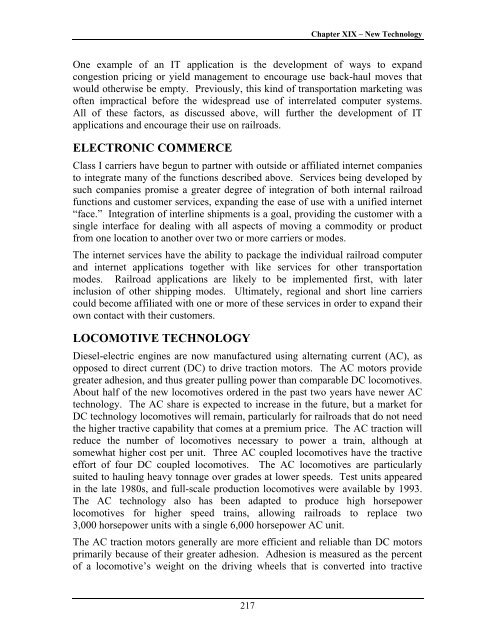California State Rail Plan 2005-06 to 2015-16
California State Rail Plan 2005-06 to 2015-16
California State Rail Plan 2005-06 to 2015-16
You also want an ePaper? Increase the reach of your titles
YUMPU automatically turns print PDFs into web optimized ePapers that Google loves.
Chapter XIX – New Technology<br />
One example of an IT application is the development of ways <strong>to</strong> expand<br />
congestion pricing or yield management <strong>to</strong> encourage use back-haul moves that<br />
would otherwise be empty. Previously, this kind of transportation marketing was<br />
often impractical before the widespread use of interrelated computer systems.<br />
All of these fac<strong>to</strong>rs, as discussed above, will further the development of IT<br />
applications and encourage their use on railroads.<br />
ELECTRONIC COMMERCE<br />
Class I carriers have begun <strong>to</strong> partner with outside or affiliated internet companies<br />
<strong>to</strong> integrate many of the functions described above. Services being developed by<br />
such companies promise a greater degree of integration of both internal railroad<br />
functions and cus<strong>to</strong>mer services, expanding the ease of use with a unified internet<br />
“face.” Integration of interline shipments is a goal, providing the cus<strong>to</strong>mer with a<br />
single interface for dealing with all aspects of moving a commodity or product<br />
from one location <strong>to</strong> another over two or more carriers or modes.<br />
The internet services have the ability <strong>to</strong> package the individual railroad computer<br />
and internet applications <strong>to</strong>gether with like services for other transportation<br />
modes. <strong>Rail</strong>road applications are likely <strong>to</strong> be implemented first, with later<br />
inclusion of other shipping modes. Ultimately, regional and short line carriers<br />
could become affiliated with one or more of these services in order <strong>to</strong> expand their<br />
own contact with their cus<strong>to</strong>mers.<br />
LOCOMOTIVE TECHNOLOGY<br />
Diesel-electric engines are now manufactured using alternating current (AC), as<br />
opposed <strong>to</strong> direct current (DC) <strong>to</strong> drive traction mo<strong>to</strong>rs. The AC mo<strong>to</strong>rs provide<br />
greater adhesion, and thus greater pulling power than comparable DC locomotives.<br />
About half of the new locomotives ordered in the past two years have newer AC<br />
technology. The AC share is expected <strong>to</strong> increase in the future, but a market for<br />
DC technology locomotives will remain, particularly for railroads that do not need<br />
the higher tractive capability that comes at a premium price. The AC traction will<br />
reduce the number of locomotives necessary <strong>to</strong> power a train, although at<br />
somewhat higher cost per unit. Three AC coupled locomotives have the tractive<br />
effort of four DC coupled locomotives. The AC locomotives are particularly<br />
suited <strong>to</strong> hauling heavy <strong>to</strong>nnage over grades at lower speeds. Test units appeared<br />
in the late 1980s, and full-scale production locomotives were available by 1993.<br />
The AC technology also has been adapted <strong>to</strong> produce high horsepower<br />
locomotives for higher speed trains, allowing railroads <strong>to</strong> replace two<br />
3,000 horsepower units with a single 6,000 horsepower AC unit.<br />
The AC traction mo<strong>to</strong>rs generally are more efficient and reliable than DC mo<strong>to</strong>rs<br />
primarily because of their greater adhesion. Adhesion is measured as the percent<br />
of a locomotive’s weight on the driving wheels that is converted in<strong>to</strong> tractive<br />
217













